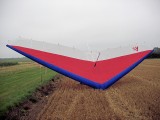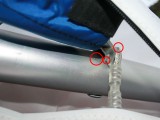Aeros Target 16 Novice Hang Glider
Note to the reader; this review is based on 15 hours clocked up on an Aeros Target 16. Prior to flying the Aeros Target I had 10 hours on an Airwave Calypso. I clip in pretty much on the maximum weight limit for this glider (100 kg). The Target is quoted as being ideal for powered units, I've only ever flown it from hills and static winch launches so can only comment on those.
Introduction
This glider is light weighing in at 26 kg, carrying it from the car to launch is a doddle. The Aeros Target is aimed at novice students and a bit strange for me, I actually preferred it to the Airwave Calypso, normally quoted as an ideal first double surface wing.
The Aeros Target is not a double surface glider (well 30% double surface). It boldy shows off its cross tubes and one of the first things you'll notice are that the cross tubes come in two sections with spring clips securing them. Why? Well simply put, this glider will 'really' short-pack down to 6 feet making it possibly one of the best gliders for transporting or storing if you have very limited space! Please note, I never did short pack the Target!
The uprights and base bar are round and the king post is aerofoiled. The control frame fits very nicely together and looks very streamlined, all secured with pip-pins. The pilot hangs from the king post.
Rigging
Generally speaking, I always rigged this glider flat. The main reason is I really struggled rigging this glider on the A-frame. I'm told it can be done, but you have to really put pressure on the king post and keel to connect the rear top-wire.
As expected, this glider is quick and easy to rig. Top battens are easily secured using the nylon threads, there are no under surface battens only dive sticks on the underside. A little care needs to be taken when lifting the nose as the side-wires can get hooked up. I found it a good idea to point the tangs on the control frame in the correct direction before lifting the nose.
Finally, the nose wire is secured using a catch and pip-pin; on this particular glider I often struggled with the pip-pin/catch assembly - getting the alignment right is very fiddly, especially on windy days!
Overall this glider is very easy and quick to rig; generally speaking, you're going to be the first person to fly with this wing; I was often wind dummy!
Short Packing
I never short packed the Target but there are two flavours of short packing, short and really short! Removal of the outward leading edges gives you standard short-pack and a more involved breakdown procedure allows the glider to be broken down to 6 feet.
Ground Handling
In light winds there is absolutely no problems moving this glider around. As the wind increases to a more moderate, I found the Target constantly wanting to nose up - this is due to the reflex, one of the features that makes this wing ideally suited to the novice. Because of this, this glider can feel much heavier than it is and I would recommend launch assist in stronger winds.
One word of warning, and I've read this in other reviews; turning the glider downwind to return to launch (as is common practice at the static winching field) you really have to be careful to keep the keel very low and the nose high; the wind has a tendency to get under the sail and if you're not careful, you're going inverted!
Take Off
This is the real strength of the Target. This glider is easy to takeoff and it's very forgiving. In nil winds, this glider lifted off my shoulders with a few steps, pulling the bar in further and accelerating until I was lifted off the ground was easy. The glider is very predictable, just what you'd expect for a novice wing.
Flying
My first flight on an Aeros Target was on completion of my BHPA CP rating. I have very fond memories of this. After qualifying I purchased an Airwave Calypso. In comparison, I found the Aeros Target much lighter in handling hence the reason I purchased one later. I simply loved flying this glider around. Pulling the bar down to my stomach the glider accelerates considerably (as does its sink rate). The glider responds with plenty of bar pressure telling you to slow. Flying close to paraglider speed, the glider still remains very controllable.
Roll rate is very light and the glider will happily turn without the pilot needing to push out. Pushing out obviously tightens the turn once initiated and it's very easy to turn this glider quickly.
In stronger winds penetration was lacking on this glider; I blame this for my first cross country flight! But for a novice wing; this glider flies perfectly! I've no complaints at all!
Landing
Of all the gliders I've flown, this by far is one of the easiest to land. Bad habit I know, but if coming in too high and stuffing the bar, this glider drops nicely meaning you can often land in very tight spaces. The flare window is very large and even if you can't manage that, this glider flies slow enough so that you can simply run it off.
Gripes
Having owned a Target for a number of years you get to know it pretty well, including some of its little annoyances! All gliders have them (I'm yet to find a glider without), so this is by no means a criticism, I'm merely sharing my own personal thoughts about things that I found frustrating.
8.1 The Nose Catch
On the Target that I've owned and others that I've helped rig, I found that inserting the pip-pin through the nose catch to secure the front wires can be a little awkward as the holes don't quite line up. With a bit of jigging around it goes, but on windy days, when the glider is constantly wanting to nose up, it can be a bit of a handful if you're doing it without assistance!
The Side Wire Tangs
Where the side wires attach to the bottom of the A-frame, there's a small steel insert that connects the cable to the airframe junction. It's possible for the side wire to wrap around this during rigging. Special care should be taken to ensure that this doesn't happen otherwise damage can occur to the cable when tensioning the glider (I once took off in this configuration and the glider shook and made a horrible noise as the cable unwrapped and straightened).
Side Wire / Leading Edge Connection
This one took a while for me to notice, but when folding the glider for rigging, it's possible for the side wire connection to the leading edge to actually contact the leading edge. Over time this contact rubs away the plastic coating covering the side wire and more importantly, it starts to wear the aluminium of the leading edge! This is one to keep an eye on - all Targets I've examined have shown wear in this area!
Conclusion
This is a perfect wing for a novice to intermediate pilot. I did my very first cross country on this glider and have very fond memories. On many light hill soaring days I often stayed up with the big boys. However, as the wind increases you'll soon hit penetration problems, but for novice pilots, I wouldn't recommend in flying in such conditions. Overall, I loved this wing and it still brings a little tear to know that I no longer have it!
Update History:





Landing.jpg)
